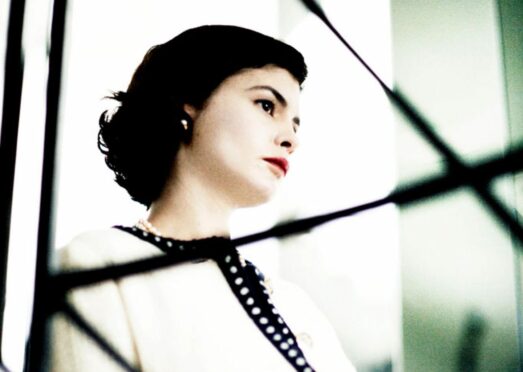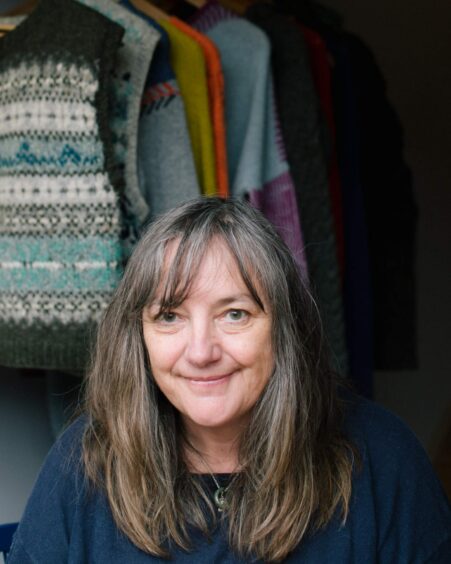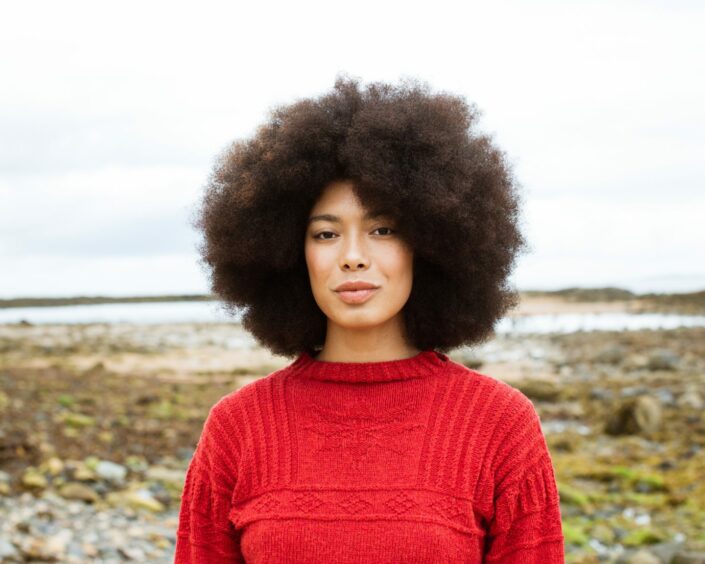
Di Gilpin arrived at a ruined croft on the Isle of Skye in 1983, with little more than a rucksack containing a tent, some assorted balls of wool and knitting needles.
She was determined to make a living from hand knitting, though she was told there was no future in the “dying art”.
Four decades on, she is one of Scotland’s leading contemporary designers and her nature-influenced aesthetic has led to collaborations with fashion brands such as Top Shop and Nike. Now her work is being showcased in a landmark exhibition celebrating the history of knitwear.
“For so many years, knitting has been – and still is, to an extent – considered one of those things your granny did, making itchy cardigans you had to wear to school, little old ladies on crofts in the middle of nowhere knitting their days away.
“But knitting can be an art form. The fashion world has always known this, but the art world has been a bit slow to catch up.”
Inspired by her mother and “Aunty” Doris, a lifelong friend her mum met while building Spitfires during the Second World War, Gilpin began her love affair with wool as a child.
“My mum knitted and so did my Aunty Doris. Aunty Doris was tiny and used to have her gloves hand-knitted and her shoes handmade.
“She was fashion conscious but found it hard to get things to fit, so she and my mum and I would go on trips to London to pick up her things and look in all the fashion stores. And, if there was something I liked, Aunty Doris would knit it for my Christmas. She’d work out the pattern in her head and come up with something almost identical. Nothing was impossible.
“It inspired me to take up knitting at a young age. In fact, an old school friend recently showed me a photograph of her and me when we were younger and she’s wearing a jumper I knitted for her. I was only about nine.”
From those humble beginnings Gilpin has honed skills that are now in high demand among leading designers.
Now based at Comielaw Farm on the Balcaskie estate in Fife, she and her team of skilled home knitters based across Scotland create the one-off pieces and special commissions desired by private clients, fashion designers and the catwalk.
A single Gilpin garment can take as long as two months to create, hand knitted in the finest lambswool, making it among the most intricate and show-stopping pieces of couture.
“Hand knitting is a special thing,” said Gilpin. “Because you are using your hands, using wool and knitting needles, there’s this amazing relationship between your body, your brain and your energy that you put into it, which I can only describe as ‘love’.
“I knit not for myself but with somebody else in mind and I love giving my pieces to people. Once I have done that it becomes an incredibly special thing because the wearer really feels it.
“The truth is, knitwear is invaluable. I have had commissions to make special pieces for people who are incredibly ill or bereaved and I feel like it adds something for them. It gives something.
“There’s an extra essence. It reminds people of their childhood, reminds them of loved ones but it also helps them feel protected when they wear it.
“Sheila Greenwell, my right-hand woman, for my birthday knitted me a beautiful cashmere shawl, and for Christmas knitted me one of my jumper designs in cashmere. I treasure those.
“They are the greatest gift because I know the amount of time and thought that went into them – and that ultimately is what knitwear is about.”
Gilpin takes her inspiration from the patterns she sees around her, mostly in nature, but also from ceramics and art.
“My inspiration comes from the Scottish landscape,” she said. “Visually, the natural world is just incredible, whether it be the patterns the waves make in the sand or the shadows from the trees. I see patterns in everything – and I’m lucky to have a photographic memory so I don’t forget them.”
Gilpin’s creations feature in a new exhibition – Knitwear, Chanel To Westwood – that charts some of Scotland’s innovative knitwear designers alongside iconic names in fashion such as Coco Chanel and Vivienne Westwood.
The private collection of more than 150 incredible pieces – owned by Mark and Cleo Butterfield, who have been hailed as the king and queen of vintage – opens next month at Edinburgh’s Dovecot Studios.
Gilpin is excited to see knitting being celebrated as an art form. She said: “My works in the exhibition sit alongside some of the biggest names in fashion and it’s so exciting.
“There has been very fine knitting in the past – pieces made for the church going back hundreds of years. Queen Elizabeth I had silk hand-knitted stockings. A lot of it is about clothing and it being a basic need, but also the innovativeness of knitters. It’s an incredible, crazy medium. When you are knitting, you are making the fabric, shape, pattern and form, so it’s sculptural and can be manipulated in so many ways.
“You can knit in different directions, you can create anything – and all using one stitch, because knitting is all one stitch. For example, purl is just a knit stitch in reverse. It’s just amazing what you can do with such a simple starting point.”
In recent years knitting has begun to shed its “granny” image thanks to a new generation discovering the creative and therapeutic benefits of the craft.
These include such celebrities as Olympic gold medal-winning diver Tom Daley, who was spotted clacking away on his knitting needles poolside at the delayed 2020 Games in Tokyo. Two years ago, pictures went viral of superstar former One Direction singer Harry Styles on stage wearing a rainbow-coloured knitted top.
Gilpin, who has run her own knitting workshops for more than 20 years, has noticed a rise in the number of young people attending her classes.
“Knitting did go into decline for a while but it’s coming back now,” she said. “Young people are making yarn, dyeing yarn, and bringing a whole new dimension and new ideas to knitting and doing really special things with it. There are definitely young, enthusiastic people coming to join.
“It is absolutely not a dying art form. It’s one that has and keeps on evolving and has a bright future ahead. We would all say knitwear has its place in history – but is set to bring big things in the years to come too.”
A ripping yarn: Gallery charts wool’s history from Highland crofts to designers’ catwalks
Knitwear, Chanel To Westwood charts more than 100 years of knitwear history from practical garments to Hollywood parties and the catwalk.
The private collection of more than 150 incredible pieces – owned by Mark and Cleo Butterfield – includes examples from Coco Chanel’s easy-wear twinsets to the novelty knits of the ’70s and the designer knitwear of the ’80s, ’90s and beyond, with pieces from the likes of Vivienne Westwood and Julien Macdonald.
It is a rare chance for fashion fans to see a complete collection of wool garments, according to Dovecot Studios director Celia Joicey. She said: “Knitwear often doesn’t survive as easily as other garments – largely because it gets worn more often, or it’s the first to get eaten by moths! It’s harder to find in museum and gallery archives than other items of fashion history.
“Fashion wasn’t always as high-profile in museum collections as it is now. When I started working in museums in the 1990s, it was rare there was a fashion exhibition.
“Fashion history and curation is such an exciting area but traditionally not as popular as painting or fine arts for museums and galleries. And sample pieces are rare. It wasn’t until the late 20th Century that many of the fashion houses recognised the importance of having a comprehensive archive.
“But they have got much better recently – and some museums and galleries (such as the Costume Institute at the Metropolitan, and the V&A) have specialised in collecting and growing their fashion expertise.”
The historical garments sit alongside traditional designs, like Pringle and Fair Isle, and there’s a contemporary element, with works by designers including Di Gilpin and April Crichton, the Scottish half of Glasgow-Parisian brand La Fetiche.
“Knitwear goes way back to before our time, long before people started knitting baby bonnets and mittens at home,” said Joicey.
“Until knitwear came to be machine-knitted and mass-produced it was really confined to underwear. We have an undergarment in the exhibition, designed to keep warm, which dates back to the Victorian era.
“In the Victorian and Edwardian era, women were shackled into corsets. But Coco Chanel changed that. By the 1920s, women felt freer to wear things for comfort than before the war.
“Her twinsets are some of the most exciting pieces in the collection. They were so radical for that time.
“The importance of knitwear in fashion can be taken for granted but this exhibition is an opportunity to celebrate knitwear’s distinctive place in Scotland’s cultural and economic history and to inspire future design directions.”
Knitwear, Chanel To Westwood opens on October 15 and runs until March 11

Enjoy the convenience of having The Sunday Post delivered as a digital ePaper straight to your smartphone, tablet or computer.
Subscribe for only £5.49 a month and enjoy all the benefits of the printed paper as a digital replica.
Subscribe
 © SYSTEM
© SYSTEM